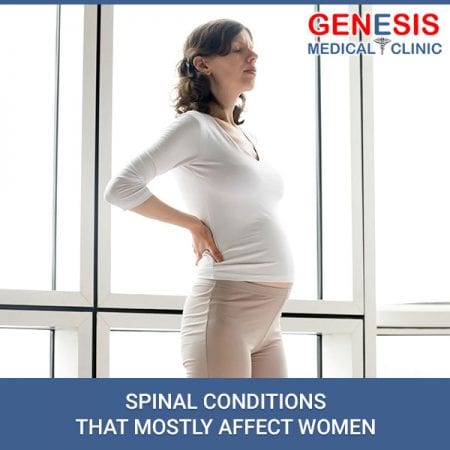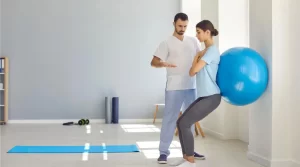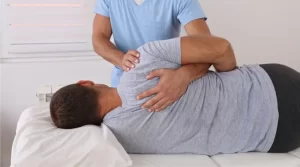
Many women deal with conditions that cause back pain, especially those that are over the age of 50. Many conditions are more common, or even exclusively found in women. In this article, we’ll be going over seven of the most common back pain causes for women.
Endometriosis
Because it is a gynecological condition, endometriosis is something that only affects those with a uterus. It causes uterine tissues to grow outside the womb, causing several painful symptoms. Common ones include severe menstrual pain in the pelvis and lower abdomen, genital pain, and lower back pain. Back and pelvic pain can become chronic, worsening during menstruation. There is no known cure, but hormonal treatments like the birth control pill and anti-inflammatory medications are often used to ease symptoms.
Table of Contents
- Tail Bone Pain (Coccydynia)
- Spinal Osteoporosis Fractures
- Spinal Osteoarthritis
- Degenerative Spondylolisthesis
- Sacroiliac Joint Dysfunction
- Piriformis Syndrome
- What Can You Do About Back Pain?
- Contact us Now!
Tail Bone Pain (Coccydynia)
The tail bone is located at the base of the spine, and coccydynia is normally caused by a trauma of some kind. Women are more at risk for a few reasons, mainly the shape and angle of the pelvis, as well as the risk of injury during childbirth.
The tail bone provides support while you’re sitting down, so an injury will normally cause pain while sitting, especially on hard surfaces, going from sitting to standing, or leaning backward while seated. The most distinct sign of coccydynia is immediate pain relief coming from standing up. Adjusting your posture or weight while sitting may also help relieve the pain.
Spinal Osteoporosis Fractures
Osteoporosis is a condition that causes the bones to lose density, making them weaker and more susceptible to fracturing. Post-menopausal women are four times more likely to develop osteoporosis than men. This is thought to be because of hormone differences that lead to more rapid bone loss.
Osteoporosis can be painful on its own, but the higher risk comes from spinal compression fractures. These fractures can cause acute pain and pain that spreads to the front where it may cause lung and heart issues.
Spinal Osteoarthritis
Spinal osteoarthritis is caused by wear and tear damage to the cartilage between your vertebrae. It’s common in women, and the main risk factors are age and weight. Pain is caused when the cartilage breaks down the bones rub against each other. The main symptoms are pain in the back, buttocks, thighs, and groin. Stiffness and pain in the morning are also common, along with occasional, intensely painful flare-ups. Pain may increase with pressure but be relieved by bending forward.
Degenerative Spondylolisthesis
Due to low estrogen levels, post-menopausal women are at higher risk for degenerative spondylolisthesis. It causes degeneration which leads to vertebrae in the spine slipping over each other. The most common symptoms are radiating lower back pain and pain while walking. The pain may be relieved by leaning forwards.
Sacroiliac Joint Dysfunction
Sacroiliac joint dysfunction is caused by a misalignment in the joint at the base of the spine. It’s more common in women because of the different sizes and angles of the joint and pelvis. It’s especially common in younger women. Symptoms include lower back pain, aches, and sharp pain which travels down the thigh. It typically worsens when you sit or lie down, or when you’re using stairs.
Piriformis Syndrome
Piriformis syndrome is caused by a muscle spasm in the buttocks. The main reason women are more often affected by changes in the pelvis from pregnancy. It often causes chronic pain in the hip area, pain when sitting, and radiating pain from the thigh.
What Can You Do About Back Pain?
Back pain may be a symptom of a deeper problem, or it has no identifiable cause for many women, but that doesn’t mean you just have to live with it. Medication, physical therapy, and lifestyle changes can all provide relief. For more help managing back pain, contact Genesis Wellness Clinic.
Contact us Now!
“Your path to vibrant health begins here. Feel free to reach out with any questions or to schedule a consultation. We’re here to support you every step of the way.”
Picture Credit: freepik




